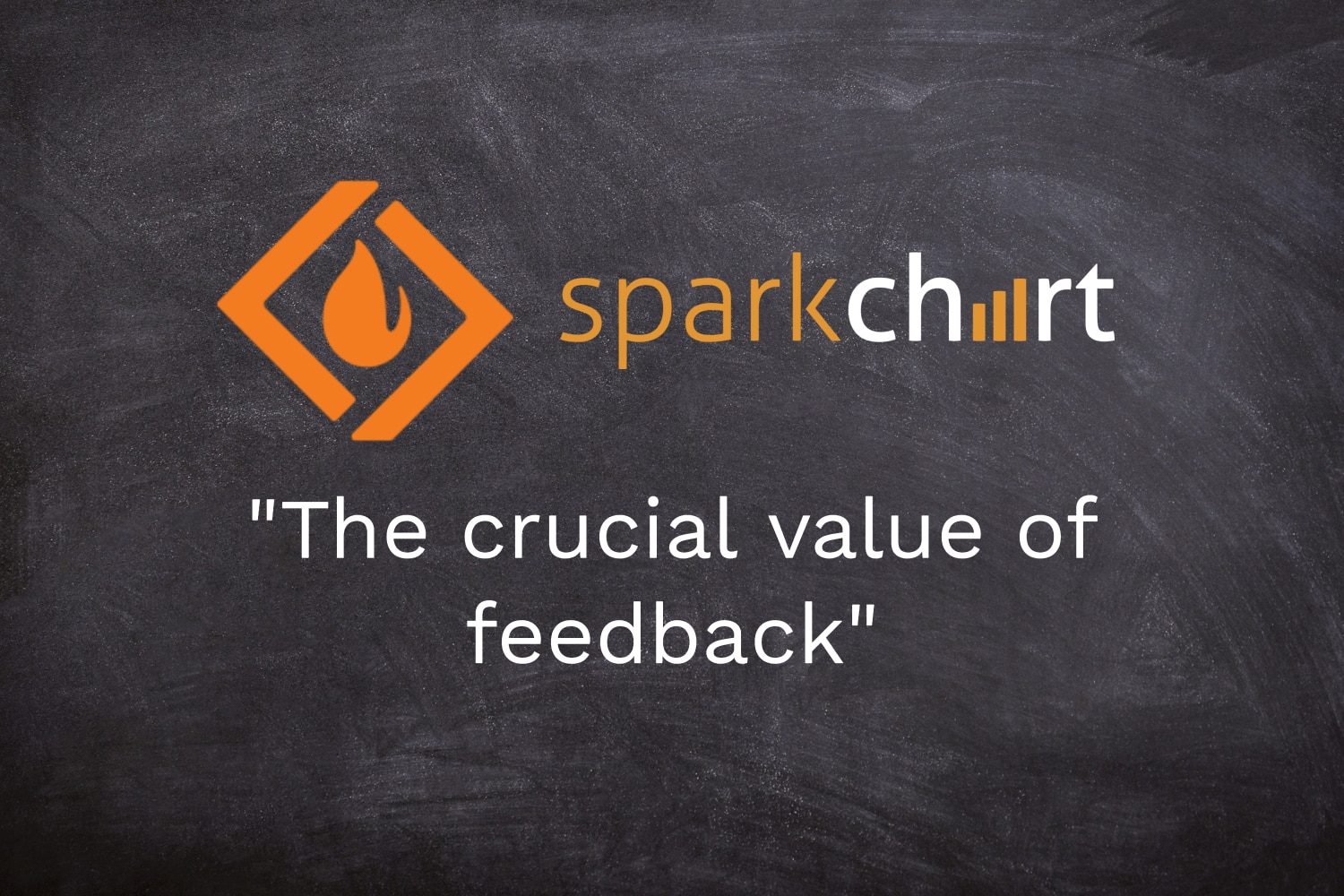SourceForge Q&A with Spark Chart on the crucial value of feedback
Spark Chart Co-founder, Mark Sinclair, was recently by interviewed by SourceForge. SourceForge offers software developers a centralized online location to control and manage free and open-source software projects. SourceForge has recently entered the field of facilitating reviews of business software products.
In the interview, Mark highlighted the importance of feedback when it comes to improving organisational performance. He noted that the vast majority of businesses are not using a survey software tool. Consequently, they are not getting as much feedback as they need. Mark also offered some advice for organisations starting down the path of getting feedback and conducting online surveys.
Q&A with Spark Chart on the crucial value of feedback and why many organizations are missing out
Getting effective feedback from customers, employees, leaders and stakeholders is one of the most critical challenges faced by businesses. Valid feedback is desperately needed in a world where business threats are emerging at an unprecedented rate. Australian start-up, Spark Chart, is helping business owners, leaders and consultants around the world tackle that very problem.
SourceForge recently spoke with Mark Sinclair, Co-founder of Spark Chart, to talk about feedback and trends they see in the field of organizational surveys. Mark has More than 25 years-experience in surveys. He says that “many businesses fail abysmally at getting valid feedback.”

Mark Sinclair, Co-Founder of Spark Chart
Mark and his co-founder, Dave Ridgway, are passionate about the difference that feedback can make. Their ambition is to provide organizations around the world with a state-of-the-art survey tool, along with expert advice and support at the most competitive price.
Q. First, can you give us an overview of Spark Chart?
Spark Chart is a survey software tool to conduct any type of survey. We help leaders and business consultants uncover hidden knowledge & ideas. We also provide survey design and consulting services if needed. But, essentially, we want to give our clients the tool, skills, resources and support to create and manage any survey project themselves.
Dave Ridgway and I are the founders. We have both been involved in feedback and surveys for many years. Dave is a highly experienced software developer. My experience is in business consulting as well as feedback. I was also an owner in a survey company for ten years. My former business partner and I sold it some years ago. Dave provided software support to that business and that is how we met.
Q. Why did you decide to build Spark Chart?
Gosh, we see a lot of bad surveys. We get them every day. I am sure that every one of your readers will have had an experience with a poorly designed survey or feedback process. The survey tool might be good. But the execution can often be very poor. That’s understandable. Surveys are complex processes. It’s hard for people with no experience, limited time or resources, and many other pressing priorities to construct a quality survey and manage the process effectively.
Feedback is central to everything we do in life and in business. In my last business we had an in-house survey software tool. Our services were quite specialized, expensive and beyond the reach of many smaller organizations, at least for them to purchase on a regular basis.
One day I suggested to Dave that we build a feature rich survey tool that was easy to use, powerful enough to do just about any type of survey and low cost so that any organization could afford it. Our aim was to provide business consultants and leaders with a tool to uncover hidden knowledge and ideas. To make it easy for them to conduct surveys and get the feedback they need. So, we started Spark Chart in 2016.
Tell us about your customers and your market. Who are they? What industries? And where are they located?
Our clients are typically leaders or business consultants in any industry. Feedback is essential in every field.
Our clients are based all around the world and they are running survey projects in many languages. I can tell you that in the past six months we have Spark Chart clients in more than 70 countries who have conducted survey projects.
We also created a special plan for consultants. We realized that business consultants were often focused on applying their own consulting processes and tools in client projects. They usually lacked the tools to help their clients conduct surveys. Consequently, they were sometimes overlooking the value of feedback to their consulting work. For us, the consultant market is an enormous opportunity.
What trends are you seeing in the survey market? Was there a specific need your saw in the market?
There are quite a few survey tools in the market. Many of them focus on niche survey purposes. Of course, there are a large providers with broad survey offerings. Despite this, our research showed that the vast majority of organizations are not getting the feedback they need. Sure, large organizations and many medium sized organizations are constantly running surveys. But most small businesses are not.
We would go as far as saying that 95% of small organizations and businesses are not using a survey tool. Those small organizations are often running in a bit of a vacuum. They are getting some feedback. But it is usually ad hoc. Consequently, they are not always making decisions with the quality information. And, getting that information can be expensive. These organizations do not have, and cannot afford, the specialist staff and resources that large organizations take for granted. Their leaders and staff are generalists and perform a wide range of roles with limited time, resources and funds.
Yet, with the right tools, getting feedback can be one of the cheapest and most valuable thing that these organizations could do to identify what they are doing well and what they need to improve or change.
That’s where Spark Chart comes in with our mission to help people uncover hidden knowledge and ideas.
Q. What advice would you give anyone looking to conduct a survey
Well, there are many mistakes that we see every day. I like to flip the biggest mistakes on their head to create the most important tips.
You must write down the clear objectives for the survey. They are critical to ensure you ask the right questions and make sure you don’t miss anything. If you don’t ask, you don’t get.
Carefully consider your audience and their needs. As a designer you must put yourself in their shoes. Too often, we see surveys that are structured for the benefit of the survey creator and not the people completing the survey.
Ask the right number of questions. Avoid creating survey fatigue where people abandon the survey. How close is your relationship with the target respondents? You can ask employees to answer longer and more complex surveys. But for a customer who buys a product make it super short and easy.
Make sure you pilot the survey. Get feedback about the survey and refine it before launching. Do not send a survey to thousands of people without first testing with smaller groups and refining.
Create the right context for people to give valid feedback. I am sure many of your readers have had a bad experience at a restaurant where the waiter came up after the meal and said (did not ask) “How was your meal”. How did you respond? “Good thanks” and left? Outside, the conversation probably turned to what was wrong with the meal and the experience. And everyone said – never going back there again. The silent majority do not say what they think unless you help them to say it. There are two losers – the restaurant and the diners. The right environment is crucial.
Remind people to complete the survey. People have busy lives. Email inboxes fill up quickly. Social media posts disappear. Send friendly reminders to maximize your response rate. And, depending on the survey objectives, possibly provide some incentive.
Q. Are there any specific challenges you face?
Surveys are complex. On top of that, we have built many powerful features into Spark Chart, covering a large range of different types of surveys for employees, leaders, customers, market research, teams, products, services and stakeholders. And that has created one big challenge. There is a learning curve for new users. We have found that after a couple of projects our users find everything pretty easy.
However, our new users typically have limited experience in conducting surveys. We want to help them see all the possibilities so that they can run effective survey projects. Our constant challenge and focus is on making it as easy as possible for new users. We have to help them see, understand and benefit from all the features that they probably don’t even know that they need.
For those reasons and more, we provide all our users 24×7 support from survey experts.
Thinking about the future of surveys, what are the likely trends you see and where does Spark Chart fit?
We are seeing a proliferation of review sites in many different fields. Customers and employees have many options for communicating their views and experience in public forums. So, being ahead of that feedback will become increasingly important.
Feedback currently tends to be a project based activity, typically driven top down. We think that will change. We see feedback becoming a primary work-related activity. Not an after-thought. We believe that feedback and surveys will become increasingly automated and central to many more activities than at present.
There will be a recognition that feedback is an opportunity to learn, develop, act and improve. The expectation will be for people to give and seek valid feedback as a daily activity. And feedback processes will be driven multiple ways, not just initiated from the top.
What value does Spark Chart provide?
With Spark Chart you get a tool for any type of feedback. Get views and ideas from employees, customers, leaders, teams, suppliers, boards and stakeholders. Survey purposes include SWOT analysis, employee engagement, leadership reviews, project reviews, board reviews, performance management, development planning, coaching and training needs analysis, Net Promoter Score, supplier reviews, brainstorming and ideas generation, event evaluation, systems assessment, safety reviews, forms and applications, testimonials and voting. The list goes on.
The software is feature rich to conduct any just about every type of survey – from the simplest to the most complex survey. We provide ready-made quality survey templates to get started straight away or you can create your own surveys. Workflows can be automated with conditional logic and integrations with other applications.
Surveys can be customized to look professional on any device. Add your own branding along with messages and instructions. We have a comprehensive range of deployment options including personalized emails, social media, autoresponders, websites and more. Responses can be tracked and managed easily. Our analytical and reporting tools are extremely powerful. Reports can be generated and shared instantly.
With Spark Chart, you don’t need to be a survey expert. The survey software does all the heavy work for you. And, we provide expert support & advice, 24 hours a day and 7 days a week!
Source: https://sourceforge.net/articles/qa-spark-chart-crucial-value-feedback-many-organizations-missing/





